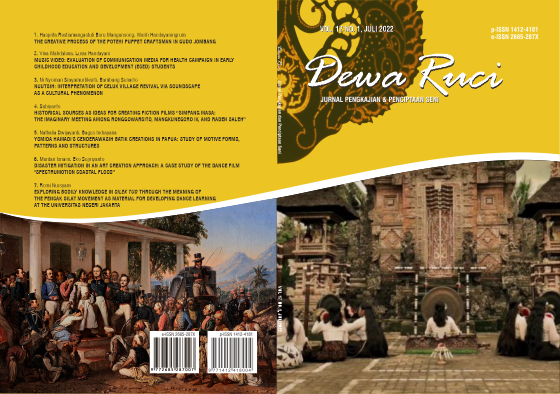The creative process of the Potehi puppet craftsman in Gudo Jombang
DOI:
https://doi.org/10.33153/dewaruci.v17i1.3506Keywords:
Puppet Potehi, Puppet craftsman, Creative Process, HokkienAbstract
Potehi Puppet is one of the traditional arts in the form of hand puppet performances from China that developed in Java, one of which was in Gudo, Jombang. This article aims to describe the creative process of the Potehi Puppet artist/maker in Gudo, which is correlated with family background and life experiences. The author finds a relationship between difficult life experiences and artistic family background with the artist's creative energy so that he can survive and continue to develop his work in difficult artistic conditions. This explains that difficult life experiences are also needed in creativity in terms of creativity theory and psychology. The method used is descriptive qualitative with interview data collection techniques with three artists/makers of Potehi Puppet in Gudo, namely Toni, Sony, and Samsul. Data analysis uses several main theoretical bases, namely Primadi Tabrani's creativity theory, and Graham Wallas's creativity, and research by Marie J.C. Forgeard is about taking advantage of adversity for increased creativity. This article can inspire artists, especially traditional artists, to take advantage of life's difficulties as a stepping stone to increasing creative energy, endurance, and creativityDownloads
References
A. Valentina and F. Tanumihardjo, “Typography as Communication Media to Revitalize Potehi Puppet (Potehi Puppet),” in the International Conference on Economics, Business, Social, and Humanities (ICEBSH 2021), 2021, pp. 212–216, doi: 10.2991/assehr.k.210805.034.
M. J. Forgeard, “Perceiving Benefits After Adeversity: The Relationship Between Self-Reported Posttraumatic Growth and Creativity,” Psychol. Aesthetics, Creat. Arts, vol. 7, no. 3, pp. 245–264, 2013. doi: 10.1037/a0031223
A. M. Kilgour, “Improving the creative process: Analysis of the effects of divergent thinking techniques and domain specific knowledge on creativity,” Int. J. Bus. Soc., vol. 7, no. 2, pp. 79–107, 2006. Available at: waikato
M. Botella, F. Zenasni, and T. Lubart, “What Are the Stages of the Creative Process? What Visual Art Students Are Saying,” Front. Psychol., vol. 9, no. 2266, pp. 1–13, 2018. doi: 10.3389/fpsyg.2018.02266
M. Joyce, K. Franklin, P. Neale, S. Kyffin, and B. Veronesi, “What Stimulates the Creative Process?,” J. Des. Technol. Educ., vol. 3, no. 2, pp. 113–116, 1998. Available at: lboro
A. G. Ganiev and S. N. Tashev, “The Role of ‘Imagination’ in the Process of ‘Creative Thinking’ Developing Students’‘Imagination’ and ‘Creative Thinking’ Skills in Teaching Physics,” Ann. Rom. Soc. Cell Biol., pp. 633–642, 2021. doi: 10.17762/pae.v58i1.1309
D. Fredericksen, “Jung/sign/symbol/film,” in Jung & film, Routledge, 2021, pp. 17–55. doi: 10.4324/9781315783284-3
P. de Silva, “The Lost Art of Sadness,” in Passion, Death, and Spirituality, Dordrecht: Springer Netherlands, 2012, pp. 175–189. doi: 10.1007/978-94-007-4650-3_13
S. W. Chong and H. Reinders, “A methodological review of qualitative research syntheses in CALL: The state-of-the-art,” System, vol. 103, p. 102646, Dec. 2021, doi: 10.1016/j.system.2021.102646.
H. Shevlin, “Rethinking creative intelligence: comparative psychology and the concept of creativity,” Eur. J. Philos. Sci., vol. 11, no. 1, p. 16, Mar. 2021, doi: 10.1007/s13194-020-00323-8.
A. Råde, “Theories Supporting the Use of Puppets as Pedagogical Tool with Young Children,” Univers. J. Educ. Res., vol. 9, no. 7, pp. 1359–1368, Jul. 2021, doi: 10.13189/ujer.2021.090702.
C. J. Valasek, “Divided Attention, Divided Self: Race and Dual-mind Theories in the History of Experimental Psychology,” Sci. Technol. Hum. Values, vol. 47, no. 2, pp. 243–265, Mar. 2022, doi: 10.1177/01622439211054455.
T. Zittoun and P. Stenner, “Vygotsky’s Tragedy: Hamlet and the Psychology of Art,” Rev. Gen. Psychol., vol. 25, no. 3, pp. 223–238, Sep. 2021, doi: 10.1177/10892680211013293.
N. S. Harth, “Affect, (group-based) emotions, and climate change action,” Curr. Opin. Psychol., vol. 42, pp. 140–144, Dec. 2021, doi: 10.1016/j.copsyc.2021.07.018.
R. W. Weisberg, “On Structure in the Creative Process: A Quantitative Case-Study of the Creation of Picasso’s Guernica,” Empir. Stud. Arts, vol. 22, no. 1, pp. 23–54, Jan. 2004, doi: 10.2190/EH48-K59C-DFRB-LXE7.
B. F. Skinner, “Are theories of learning necessary?,” Psychol. Rev., vol. 57, no. 4, pp. 193–216, 1950, doi: 10.1037/h0054367.
D. Bayliss, “The Rise of the Creative City: Culture and Creativity in Copenhagen,” Eur. Plan. Stud., vol. 15, no. 7, pp. 889–903, Aug. 2007, doi: 10.1080/09654310701356183.
H. Kuardhani, Toni Harsono Maecenas Potehi dari Gudo. Yogyakarta: Isac Book, 2011. Available at: Google Books
R. Cowdroy and A. Williams, “Assessing creativity in the creative arts,” Art, Des. Commun. High. Educ., vol. 5, no. 2, pp. 97–117, Jan. 2007, doi: 10.1386/adch.5.2.97_1.
R. Weisberg, “The study of creativity: From genius to cognitive science,” Int. J. Cult. policy, vol. 16, no. 3, pp. 235–253, 2010. doi: 10.1080/10286630903111639
K. Rivett, “Graham Wallas,” Aust. Q., vol. 23, no. 2, p. 93, 1951, doi: 10.2307/20633352.
J. Piirto, “Creativity for 21st Century Skills,” in Creativity for 21st Century Skills, Rotterdam: SensePublishers, 2011, pp. 1–12. doi: 10.1007/978-94-6091-463-8_1
Downloads
Published
Issue
Section
License
Authors who publish in Dewa Ruci: Jurnal Pengkajian dan Penciptaan Seni agree to the following terms:
- Authors retain copyright and grant the Dewa Ruci: Jurnal Pengkajian dan Penciptaan Seni right of first publication with the work simultaneously licensed under a Creative Commons Attribution License (CC BY-SA 4.0) that allows others to share (copy and redistribute the material in any medium or format) and adapt (remix, transform, and build upon the material) the work for any purpose, even commercially with an acknowledgment of the work's authorship and initial publication in Dewa Ruci: Jurnal Pengkajian dan Penciptaan Seni.
- Authors are able to enter into separate, additional contractual arrangements for the non-exclusive distribution of the journal's published version of the work (e.g., post it to an institutional repository or publish it in a book), with an acknowledgment of its initial publication in Dewa Ruci: Jurnal Pengkajian dan Penciptaan Seni.
- Authors are permitted and encouraged to post their work online (e.g., in institutional repositories or on their website) prior to and during the submission process, as it can lead to productive exchanges, as well as earlier and greater citation of published work (See The Effect of Open Access).
This work is licensed under a Creative Commons Attribution 4.0 International License












